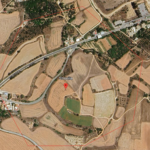As my project develops, I’ve spent time refining the theoretical frameworks that shape my approach. Strovilia is not just a site of loss, but also of memory, resilience, and potential. To capture that complexity, I’ve chosen to draw on Living Heritage, Contested Heritage, Heritage in Conflict Zones, and Futures Studies as my core conceptual lenses.
Rooted in the work of Smith (2006) and Harrison (2012), Living Heritage emphasizes the dynamic and evolving nature of intangible cultural practices, shaped by communities in response to their realities. In the context of Strovilia, this includes rituals, storytelling, and everyday acts once tied to spaces like the coffee shop and church.
To deepen this understanding, I draw on Hamilakis’ (2014) concept of sensory and affective experience, which positions heritage not just as practice but as embodied memory—felt, sensed, and remembered through taste, sound, and spatial familiarity. This has been particularly influential in shaping my methodology, where oral histories and memory mapping are designed to capture these affective layers of heritage.
Strovilia, positioned at the intersection of competing jurisdictions and shaped by a history of division, exemplifies the complexity of managing heritage in conflict zones. Tunbridge and Ashworth (1996) highlight how political instability often turns heritage into a site of tension, resistance, or erasure. Closely tied to this is the concept of Contested Heritage, which helps frame Strovilia as a space where memory and identity are negotiated, not only among former residents but also in relation to broader state narratives and control over access.
Futures thinking, informed by scholars like Graham and Howard (2008), introduces the idea that heritage should not only be preserved but adapted and reimagined. This perspective is especially relevant in spaces like Strovilia, where community presence has diminished but cultural memory remains. Futures Studies provides the tools to explore how communities might actively shape their heritage in response to political and social uncertainty, whether through digital archives, storytelling, or participatory mapping.
Each of these frameworks contributes to a layered understanding of Strovilia. Living Heritage centers the community’s embodied experiences; Contested Heritage and conflict-based perspectives provide the structural and political backdrop; and Futures Studies pushes the project toward forward-looking, community-driven strategies for resilience and cultural continuity. Together, they allow me to ask not only what has been lost, but also what can be sustained, reimagined, or reclaimed.
Initially, I considered incorporating Post-Colonial Theory into this framework. However, after engaging more deeply with the literature and the specificities of my case study, I chose to focus on approaches that speak more directly to the lived experience of heritage in contested spaces, as well as those that offer practical, future-oriented tools for communities. This decision has allowed for a more cohesive and grounded theoretical foundation.
C.C.
References
Graham, B., & Howard, P. (2008). The Ashgate Research Companion to Heritage and Identity. London: Ashgate.
Hamilakis, Y. (2014) Archaeology and the senses : human experience, memory, and affect. Cambridge: Cambridge University Press.
Harrison, R. (2012). Heritage: Critical Approaches. London: Routledge.
Smith, L. (2006). Uses of Heritage. London: Routledge.
Tunbridge, J.E., & Ashworth, G.J. (1996). Dissonant Heritage: The Management of the Past as a Resource in Conflict. London: Wiley.


